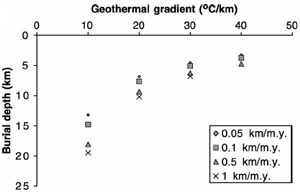| |||||||
|
|
|||||||
|
|
|||||||
| Strength of Sandstone Affected by Quartz Cementation | |||||||
|
Quartz cement is formed during the diagnostic process and is one of the two most abundant cements in sandstones. Quartz cementation during burial decreases the porosity and increases the strength of sandstones. Deformation in the subsiding basin thus transitions from ductile to brittle. Since the quartz cement is temperature controlled, the depth of this ductile-brittle transition is shown to partly depend upon the geothermal gradient of the subsiding basin. Fisher, et al. (2003) simulated the quartz cementation in numerical models. Their results (Figure 1) suggested that increases in geothermal gradient are associated with a reduction in the depth of the transition. The transition occurs at 13 to 19 km under a geothermal gradient of 10 degrees per km, while under a geothermal gradient of 40 degrees per km, it occurs at around 2 km.
Prior to the ductile-brittle transition where extensive quartz cementation occurs, pressure solution seams and deformation bands form. After the transition, joints are favored. Faults form both before and after the transition. However, they tend not to affect or impede fluid flow prior to pervasive quartz cementation; although they tend to form conduits afterwards. | |||||||
| Reference: |
|||||||
| Fisher, Q.J., Casey, M., Harris, S.D., Knipe, R.J., 2003 Flodin, E.A., Prasad, M., Aydin, A., 2003 |
|||||||
|
Readme | About Us | Acknowledgement | How to Cite | Terms of Use | Ⓒ Rock Fracture Knowledgebase |
|||||||
